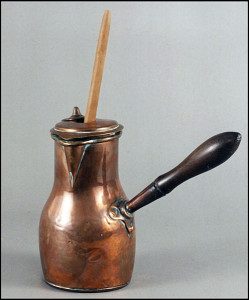
Original chocolate pot c. 1750-1800, Colonial Williamsburg
The easiest way is what we could call “hot cocoa”. This was a very common breakfast drink for the gentry and upper class (aka anyone who could afford it). It was also often served at coffee houses (in fact, White’s started out as a “Chocolate House”). It was generally made with water (not milk, alas) with a “mill” which very much resembles a simpler version of the wooden whisk (molinillo) that is used to make Mexican hot chocolate today (which makes sense when you think about it, as Europe got chocolate from Mexico in the first place so the method of making it would remain the same).
This basic directions are thus (from Experienced English Housekeeper, 1769): “Scrape four ounces of chocolate and pour a quart of boiling water upon it, mill it well with a chocolate mill, and sweeten it to your taste, give it a boil and let it stand all night, then mill it again very well, boil it two minutes, then mill it till it will leave a froth upon the top of your cups.”
I’ve also found this recipe from 1814 which more closely resembles modern hot cocoa, being made with milk. And I like ease of it. Nice to have something made up that can be used for the whole week.
Many of the cookery books of the day have various chocolate tarts, biscuits, pastils (which are basically spot-on modern nonpareils), and even ice cream. So while I haven’t (yet!) found a bonbon with a cream center, I have found PLENTY of delicious options for our characters to enjoy. Below are a few of these for you to explore.

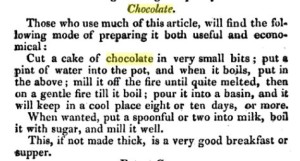
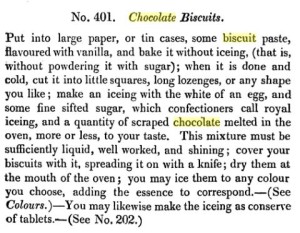
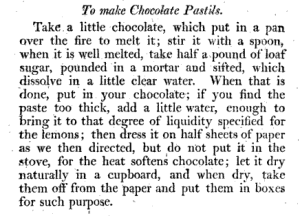
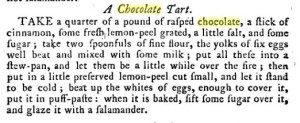

Thanks for the recipes, Isobel! I must try some of them sometime. I’ve done a few experiments in period cooking (probably nowhere near as many as you have). The results are not always perfect but it’s always fun.
Lovely. I’d like to try making some of these. Would plain unsweetened chocolate do in these recipes?
Yes, unsweetened baking chocolate is what you’d want to use.
Isobel, chocolate has been on my mind –my heroine just had a cup of cocoa upon waking up, and I was trying to decide if this was a special treat (it’s Christmas morning) in her household, or a regular everyday occurrence. This depends, of course, on the prosperity of the home, and other things -always so many things to decide!! Anyway, thanks for reminding us that there are all these other perfectly period ways to indulge our characters. Yum!
Always great information, Isobel! And I simply have no choice but to try these in the interest of research, you know!